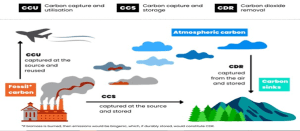TAG: GS 3: ENVIRONMENT
THE CONTEXT: The draft decisions taken at COP28 at Dubai have referred to the abatement and removal of carbon emissions using carbon capture and storage (CCS) and carbon-dioxide removal (CDR) technologies.
EXPLANATION:
- Considering the meaning of the word ‘abatement’ has become an important bone of contention, understanding the meaning and limitations of CCS is important – as also those of
- At COP28, the term “unabated fossil fuels” has come to mean the combustion of these fuels without using CCS technologies to capture their emissions. Draft decision texts point to a need to “phase out” such unabated fossil fuels. On the other hand, removal has been referenced in the context of the need to scale zero- and low-emission technologies and support forest restoration as a means to promote emission removal.
WHAT ARE CCS AND CDR?
- CCS refers to technologies that can capture carbon dioxide (CO₂) at a source of emissions before it is released into the atmosphere.
- These sources include the fossil fuel industry (where coal, oil and gas are combusted to generate power) and industrial processes like steel and cement production.
- CDR takes the forms of both natural means like afforestation or reforestation and technologies like direct air capture, where machines mimic trees by absorbing CO₂ from their surroundings and storing it underground.
- There are also more complex CDR technologies like enhanced rock weathering, where rocks are broken down chemically and the resulting rock particles can remove CO₂ from the atmosphere. Other technologies like bioenergy with carbon capture and storage (BECCS) capture and store CO₂ from burning biomass, like wood.
HOW WELL DO CCS AND CDR NEED TO WORK?
- While their technical details are clear, scientists have questions about the scale at which CCS and CDR are expected to succeed.
- The Sixth Assessment Report (AR6), prepared by the United Nations Intergovernmental Panel on Climate Change (IPCC), deals with climate mitigation. It relies a lot on the use of CDR for its projections related to the world achieving the goal of limiting the world’s average surface temperature increase to 1.5 degrees C with no or limited overshoot.
- The emission scenarios that the IPCC has assessed have more than a 50% chance of limiting warming to 1.5 degrees C assume the world can sequester 5 billion tonnes of CO₂ by 2040. This is more than India emits currently every year. There is no pathway to 1.5 degrees celsius in AR6 that doesn’t use CDR.
- If CO₂ emissions continue at current levels, we will have a 50% chance of exceeding 1.5 degrees C compared to pre-industrial levels in seven years .
- To achieve the decrease in CO₂ emissions by direct mitigation would be nearly impossible at this point and would require a lot of
HOW WELL DOES CDR WORK?
- CDR methods like afforestation, reforestation, BECCS, and direct air capture are constrained by their need for land.
- Land is often considered to be ‘viable’ for planting trees and deploying other large-scale CDR As a result, such CDR projects can adversely affect land rights of indigenous communities and biodiversity and compete with other forms of land-use, like agriculture that is crucial for ensuring food security.

WHAT ARE OTHER PITFALLS OF CCS AND CDR?
- By removing CO₂ from their environment, there are concerns that CCS and CDR create more ‘room’ to emit the greenhouse gas. In some cases, CCS has also been used to inject captured CO₂ is into oil fields to extract more oil.
- In future emissions scenarios that the IPCC has assessed, the world’s use of coal, oil, and gas in 2050 needs to decline by about 95%, 60%, and 45% respectively from their use in 2019 to keep the planet from warming by less than 1.5 degrees C. But without CCS, the expected reductions are 100%, 60%, and 70% for coal, oil, and gas by 2050.
- In a recent paper, an international group of researchers wrote that higher use of CCS and CDR make way for emissions pathways with a higher contribution from gas.
CONCLUSION:
There is need to identify viable and scalable CDR methods and need to figure out financial mechanism for CDR at a large scale in the future.
Spread the Word

Related posts
GST 2.0-NEXT‑GEN GST
French System of government and its comparison with India
A CASE OF EMPATHY: THE SC TO THE SOLDIER’S RESCUE